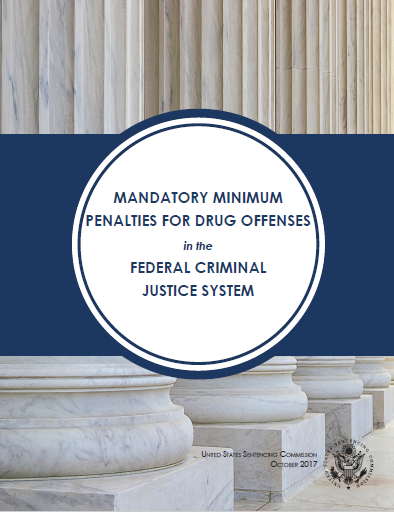Summary

- Full Report
- Report-At-A-Glance
- Quick Facts on Mandatory Minimum Penalties
- Related Reports:
Browse the publication by section:
- Section One Introduction
- Section Two Key Findings
- Section Three Drug Mandatory Minimums in the Federal System
- Section Four Data Analysis
- Section Five Conclusion
- Appendices
Key Findings
Building directly on previous reports and the analyses set forth in the 2017 Overview Publication, this publication examines the use and impact of mandatory minimum penalties for drug offenses. As part of this analysis, the Commission makes the following key findings:
- Drug mandatory minimum penalties continued to result in long sentences in the federal system.
- Mandatory minimum penalties continued to have a significant impact on the size and composition of the federal prison population.
- Offenses carrying a drug mandatory minimum penalty were used less often, as the number and percentage of offenders convicted of an offense carrying a mandatory minimum penalty has decreased since fiscal year 2010.
- While fewer offenders were convicted of an offense carrying a mandatory minimum penalty in recent years, those who were tended to be more serious.
- Drug mandatory minimum penalties applied more broadly than Congress may have anticipated.
- Statutory relief plays a significant role in the application and impact of drug mandatory minimum penalties and results in significantly reduced sentences when applied.
- Additionally, drug mandatory minimum penalties appear to provide a significant incentive to provide substantial assistance to the government pursuant to 18 U.S.C. § 3553(e) and the related guideline provision at USSG §5K1.1.
- However, neither the statutory safety valve provision at 18 U.S.C. § 3553(f) nor the substantial assistance provision at 18 U.S.C. § 3553(e) fully ameliorate the impact of drug mandatory minimum penalties on relatively low-level offenders.
- There were significant demographic shifts in the data relating to mandatory minimum penalties.
- Although likely due in part to an older age at release, drug trafficking offenders convicted of an offense carrying a drug mandatory minimum penalty had a lower recidivism rate than those drug trafficking offenders not convicted of such an offense.
